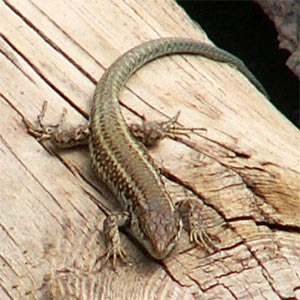- Lacertidae
Taxobox
name = Lacertidae

image_width = 240px
image_caption = "Podarcis hispanica "
regnum =Animal ia
phylum = Chordata
classis = Reptilia
ordo =Squamata
familia = "Lacertidae"
subdivision_ranks = Genera
subdivision = Many, see text.Lacertidae is the family of the wall lizards, or true lizards, which are native to
Europe ,Africa , andAsia . The group includes the genus "Lacerta", which contains some of the most commonly seen lizard species in Europe.Habitat
The European and Mediterranean species live mainly in forest and scrub habitats. "Eremias" and "Ophisops" species replace these in the grassland and desert habitats of Asia. African species usually live in rocky, arid areas. "Holaspis" is one of the few arboreal lacertids, and its single species, "Holaspis guentheri", is a glider (although apparently a poor one), using its broad tail and flattened body as an aerofoil [Zug et al. 2001Citation broken|date=August 2008] .
Appearance and biology
Lacertids are small or medium-sized lizards. Most species are less than 9 cm long, excluding the tail, although the largest living species, "Gallotia stehlini", reaches 46 cm, and some extinct forms were larger still. They are primarily insectivorouscite book |editor=Cogger, H.G. & Zweifel, R.G.|author= Bauer, Aaron M.|year=1998|title=Encyclopedia of Reptiles and Amphibians|publisher= Academic Press|location=San Diego|pages= 163-165|isbn= 0-12-178560-2] . An exception is "Meroles anchietae", one of the few wall lizards that regularly eats seeds – an appropriate food for a lizard of the harsh
Namib Desert .Lacertids are remarkably similar in form, with slender bodies and long tails, but have highly varied patterns and colours, even within the same species. Their scales are large on the head, which often also has
osteoderm s, small and granular on the back, and rectangular on the underside. Most species are sexually dimorphic, with the males and females having different patterns.At least eight species are
parthenogenetic Fact|date=August 2008, and three species give birth to live young, including theviviparous lizard , "Zootoca vivipara".Classification
Family Lacertidae
*Subfamily Gallotiinae
**Genus "Gallotia "
**Genus "Psammodromus "*Subfamily Lacertinae
**Genus "Acanthodactylus "
**Genus "Adolfus "
**Genus "Algyroides "
**Genus "Anatololacerta "
**Genus "Atlantolacerta "
**Genus "Australolacerta "
**Genus "Dalmatolacerta "
**Genus "Darevskia "
**Genus "Dinarolacerta "
**Genus "Eremias "
**Genus "Gastropholis "
**Genus "Heliobolus "
**Genus "Hellenolacerta "
**Genus "Holaspis "
**Genus "Iberolacerta "
**Genus "Ichnotropis "
**Genus "Iranolacerta "
**Genus "Lacerta"
**Genus "Latastia "
**Genus "Meroles "
**Genus "Mesalina "
**Genus "Nucras "
**Genus "Ophisops "
**Genus "Parvilacerta "
**Genus "Pedioplanis "
**Genus "Philochortus "
**Genus "Phoenicolacerta "
**Genus "Podarcis "
**Genus "Poromera "
**Genus "Pseuderemias "
**Genus "Takydromus "
**Genus "Timon "
**Genus "Tropidosaura "
**Genus "Zootoca "References
Wikimedia Foundation. 2010.
